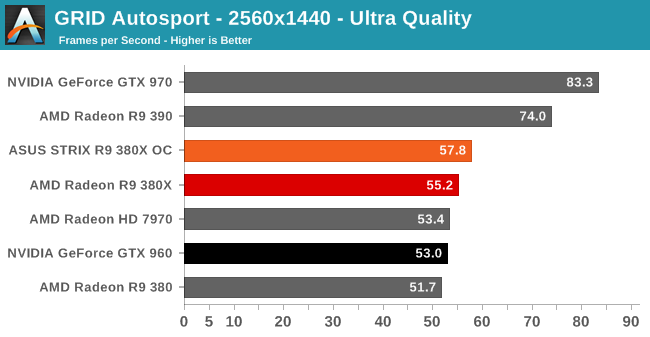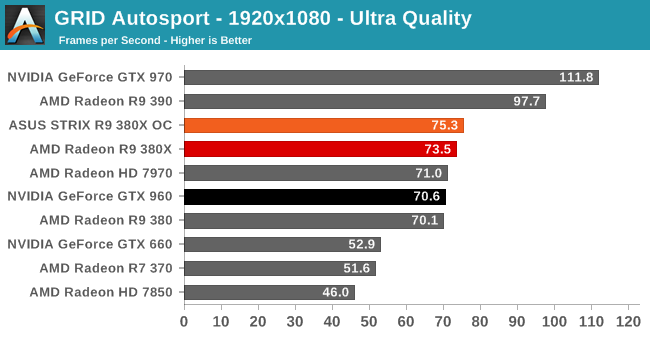The AMD Radeon R9 380X Review, Feat. ASUS STRIX
by Ryan Smith on November 23, 2015 8:30 AM EST- Posted in
- GPUs
- AMD
- Radeon
- Asus
- Radeon 300
GRID Autosport
For the racing game in our benchmark suite we have Codemasters’ GRID Autosport. Codemasters continues to set the bar for graphical fidelity in racing games, delivering realistic looking environments layered with additional graphical effects. Based on their in-house EGO engine, GRID Autosport includes a DirectCompute based advanced lighting system in its highest quality settings, which incurs a significant performance penalty on lower-end cards but does a good job of emulating more realistic lighting within the game world.


With GRID: Autosport we’re back to a close race between the R9 380X and the GTX 960. This is a game where the R9 380 and GTX 960 were virtually tied to begin with, so the additional CUs put the R9 380X over the edge. At the same time however the additional CUs only buy the card a 5% performance advantage over the R9 380, so for AMD it’s not as large of a lead over the GTX 960 as they’d like to see.
On a side note, when testing cards for this article we discovered that AMD has finally fixed their driver bottleneck on this game. So cards like the R9 390 can do better than 80fps and take better advantage of what the latest crop of 144Hz Freesync monitors can offer.










101 Comments
View All Comments
CaedenV - Monday, November 23, 2015 - link
My guess is that these cards are factory OC'd, which means that they would need to be underclocked to run an apples-to-apples comparison at true 'stock' settings.Zeus Hai - Monday, November 23, 2015 - link
Can anyone confirm that AMD's Frame Limiter still doesn't work on Windows 10?nathanddrews - Monday, November 23, 2015 - link
That's news to me.Just for you, I tested it using my i3-2100/HD7750/W10 test mule. VSync globally disabled in CCC, VSync disabled in Dota 2, Frame Target set to 60fps. Steam overlay shows 60fps and I see no signs of tearing or stuttering. To my knowledge, it never stopped working.
Zeus Hai - Monday, November 23, 2015 - link
Hmm.., it should have some tearing because it doesnt really sync with the monitor anyway, mate. Can you set it to 65, 70, 75? Mine doesnt work in LoL, I set it to 60, but it always fires up over 150fps+Dirk_Funk - Monday, November 23, 2015 - link
LoL does have its own fps limiter, so perhaps that's causing a mix-up in the software. Also, LoL might be running in fake fullscreen mode whereas the catalyst fps limiter specifies it will "Reduce power consumption by running full-screen applications at reduced frame rates." I'm gonna go try a round of LoL now because you have me curious.Asomething - Tuesday, November 24, 2015 - link
Mine does, was just benching my new 290x and forgot to turn it off so my results were skewed by the 75fps frame cap i set.nirolf - Monday, November 23, 2015 - link
There's "ASUS R9 Fury OC" mentioned in the first table in the Overclocking section.Ryan Smith - Monday, November 23, 2015 - link
Thanks.Shadowmaster625 - Monday, November 23, 2015 - link
Tonga is an epic disaster. It is less than 10% more efficient than tahiti in terms of performance per watt, and in terms of performance per transistor (fps per mm^2) it apeears to be actually worse. Meanwhile, Nvidia releases maxwell which outperformas kepler on both these metrics not by some paltry 10% or less, but by a very wide margin.CiccioB - Tuesday, November 24, 2015 - link
All the GCN architecture is a disaster.With TeraScale architecture AMD could fight with smaller dies and less W for a bit less performance.
With GCN AMD has to compete using larger and power hungry dies that have brought it to go in red also in the graphics division, while with older TeraScale it at least could be at least on par.
GCN is an architecture not up with that of the competition.
DP64 presence is not the problem, as AMD has kept on reducing it influence over every GCN step (starting from 1/4FP and ending to 1/24FP) with no real results under the power consumption term. They probably could just spare few mm^2 on the die, but they are too way back with memory compression (I can't really believe they never thought about that) and their bus are way too big, expensive and power hungry.
All the architecture is a fail. And DX12 is not going to solve anything, as if they ever raise their performances of 10% over the competition, they are still way back in efficiency both in terms of W and die size.